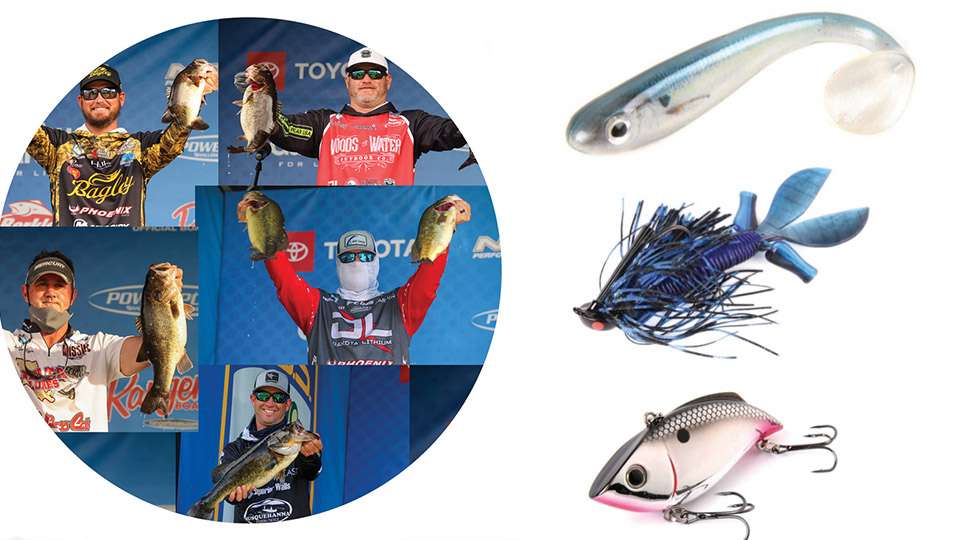
The first month of the second quarter means different things for different latitudes, so you’ll hear talk of prespawn, spawn and postspawn activity. Spring stages vary, but one simple truth does not: those bragging-rights studs may be in their most vulnerable time of the year, but boating one requires a solid strategy. Follow this advice from our Bassmaster Elite Series experts and April may deliver your P.B.
Editor’s note: Land of Giants Fall | Winter | Summer | Spring

Greg DiPalma
Deeper docks lining the canals and coves leading into protected spawning areas are pure prespawn gold — particularly when hefty, staging fish need a cold-front fallback option. Nevertheless, DiPalma’s going to invest the effort into searching for the ultimate supply-and-demand scenario.
“If there is grass present, that’s No. 1, for sure,” the pro from New Jersey said. “Our grass in the Susquehanna River dies off every winter because the water gets so cold, but by the end of March or early April, the vegetation starts to come back really strong.
“If you’re one of the first to find those patches of grass before anyone else does, you can almost win every tournament. Whether it’s in a marina or on a giant flat, two things are happening: fish are looking to spawn and fish are looking to eat, so the grass offers a great ambush point so they can feed up before their spawn.”
DiPalma knows those big prespawners want a hefty meal, so he works the new grass with a 1/2-ounce white or black/blue Z-Man ChatterBait JackHammer paired with a matching Yamamoto Zako. Making contact with the grass and occasionally ripping the bait from a snag triggers the aggressive fish.
If grass scarcity has him running docks, DiPalma relies mostly on a green pumpkin or black/blue jig with a bulky creature bait trailer.
Now, tidal fisheries can be notoriously fickle, as the daily ebb and flow repositions fish and impacts shallow-water access. Definitely points to consider, but DiPalma demystifies this habitat by pointing out a nuts-and-bolts reality that works in his favor.
“I don’t think it’s so much about their positioning; I think it comes down to their feeding windows,” he said.
“If you have a canal or a grass flat, a falling tide concentrates everything a lot more.
“In a canal with fish holding on docks, the last two hours of an outgoing tide is going to wash all that bait right in front of their faces. On a flat, your first growth of new grass is going to appear on some kind of contour. That being said, when you have that water being sucked out, that contour is where everything is going to funnel into.”
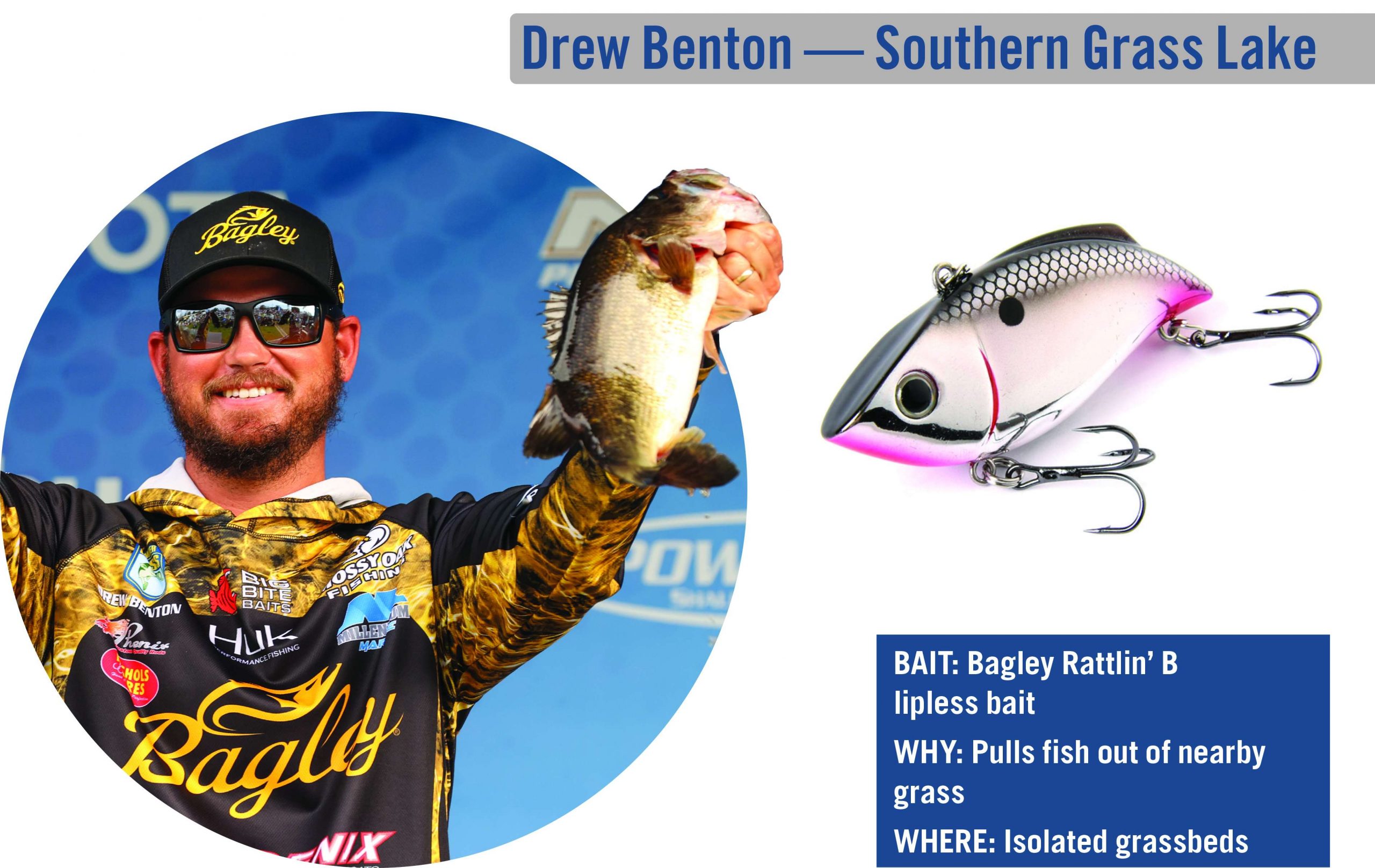
Drew Benton
Figuring that the remaining prespawners offer his best opportunity for April giants, Benton bases his game plan on one simple truth: the whoppers aren’t into the group thing. With several years of experience guiding their seasonal decisions, these fish avoid the younger crowd.
“I don’t catch the true giant ones mixed in with 5- to 6-pounders; they get extremely solitary,” Benton said. “You’re fishing for singles, so [you] can’t get discouraged if you’re not catching numbers. You have to get focused on the fact that you’re only going to get one or two bites.”
Using Lake Seminole as an example, Benton knows the giants won’t swim all the way into those prime spawning pockets. Avoiding the traffic, they’ll use the shallow parts of secluded spots Benton finds on Google Earth — for example, a hidden backwater pond where a big fish has lived most of its life.
“Also, grass lakes are typically very clear, so you can see the sandbars off the bank,” Benton said. “These can be the gems of spawning season. The big fish that live offshore will move up to bars and spawn.
“The key places are subtle depth changes. You’ll see the bright color of the sandbars and, in between, the darker shade is usually deeper water. This is where the big solitary prespawners will stage before moving up.”
While he often uses a big glide bait to tempt big fish into showing themselves, Benton does much of his giant hunting with a 7-inch Big Bite Baits Suicide Shad on a 7/0 Owner Beast belly-weighted hook, a Bagley Rattlin’ B lipless bait and a Z-Man JackHammer with a Big Bite Baits Kamikaze Swimon trailer. The key for all, he said, is winding smoothly through the grass.
“Whenever you’re targeting big fish in grass lakes, I feel like they get used to people ripping baits through the grass, so you want to just keep your rod tip up and feather it through there with minimal commotion,” Benton said. “A baitfish isn’t going to make that much commotion, and I think when you rip a bait like that, it will turn a big fish off. It’s just more natural to feather it through there.”
Of course, if his lipless bait gets snagged in the grass, he will rip it out to test the reaction bite.
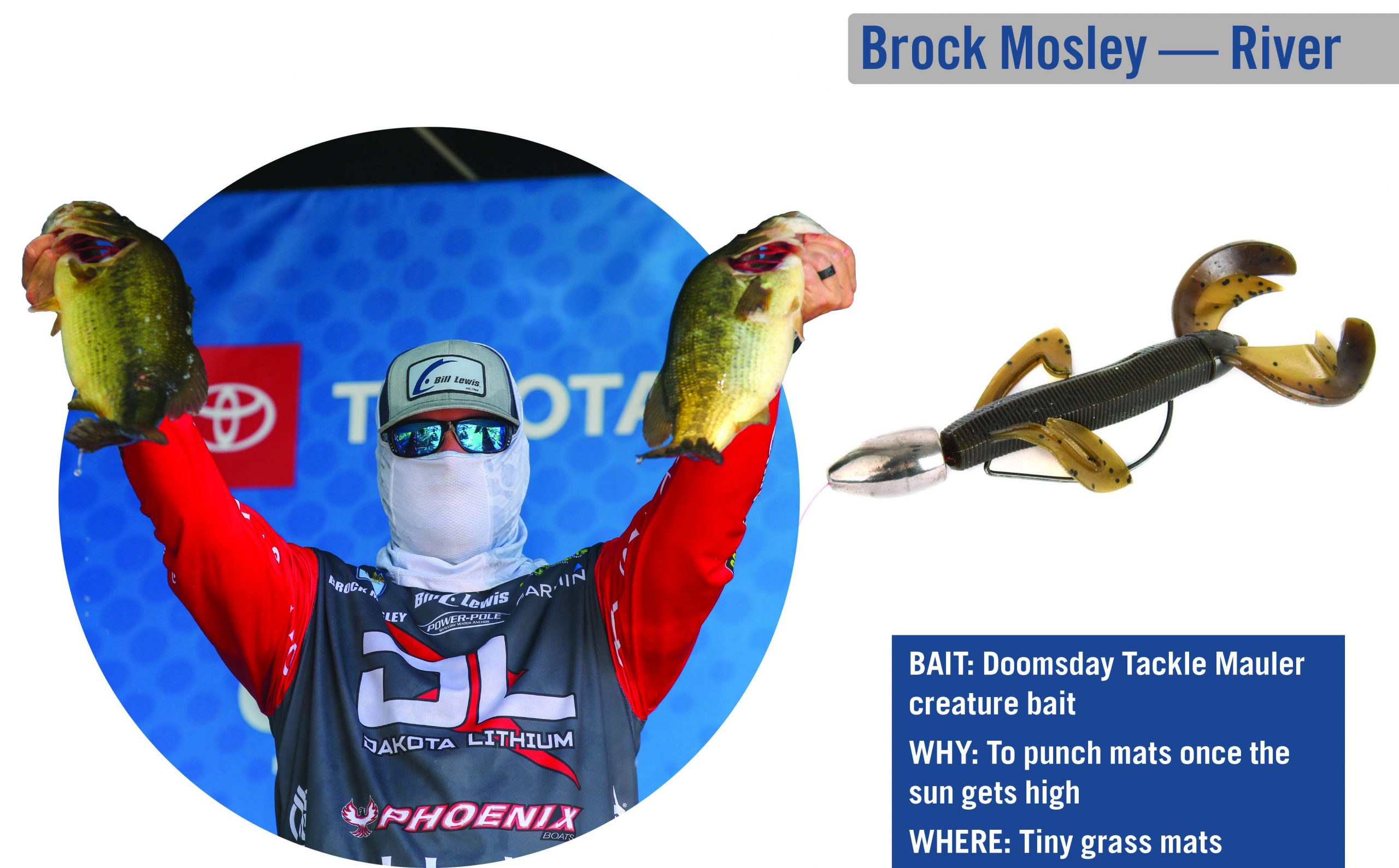
Brock Mosley
The Mississippi angler knows that most Southern rivers hold a lot of vegetation, particularly hyacinth or trash mats. On waters like the Tombigbee River, where he spends a lot of time, these canopies play a two-part role in nurturing big postspawners. The first involves food.
“April can be really good for the shad spawn, and they love to spawn around those mats,” Mosley said. “Those big fish will hang around those mats because the shad spawns provide the easy meals they need while they’re recovering from the spawn.”
Mosley said he looks for mats pushed up against cypress trees or anything that can catch the floating vegetation and provide additional cover. First light brings peak opportunity, with the optimal balance of visibility and fish activity, so Mosley wants to be hitting his best mats when daybreak finds the heavyweights chewing.
“If you have an isolated mat, even better, and I’d rather have a smaller mat than a big one,” Mosley said. “That way, you can hit as many as you possibly can, because it doesn’t take but a few minutes to fish them out.”
Mosley leverages the shad spawn activity by swimming a white/chartreuse swim jig with a white Yamamoto Double Tail Grub around the mat’s perimeter. Once that early morning flurry fades, Mosley avoids the common mistake of abandoning the mats. Rather, he’ll simply adjust with the fish.
“When the sun gets higher, that’s when I’ll go to a 1- or 1 1/2-ounce weight and start punching those mats with a black/blue or green pumpkin creature bait,” he said. “Usually April is warming in the South, and the water can get into the 70s, so the fish are not as lethargic as they are in February or March, when you have to entice them with a slow [punching] presentation.
“I punch my bait through the mat, let it free fall, and then pull back to the underside of the mat and hold it for a second. I’ll let it fall again and then pull it out. This mimics a bream, baitfish or crawfish pecking at the bottom of the mat.”
As he relocates to each new mat throughout the day, Mosley approaches with a few swim jig casts. Even with a high sun, he doesn’t want to waste good opportunities.
“Sometimes, there may be an aggressive fish right around the edge, and when you get up close to a mat, you may spook them,” Mosley said. “That’s why I always start with a swim jig.
“Also, look for birds; they will tell you where the shad are. You’ll quickly see if there are fish on them. They’ll be up chasing, and you’ll get bit right away.”
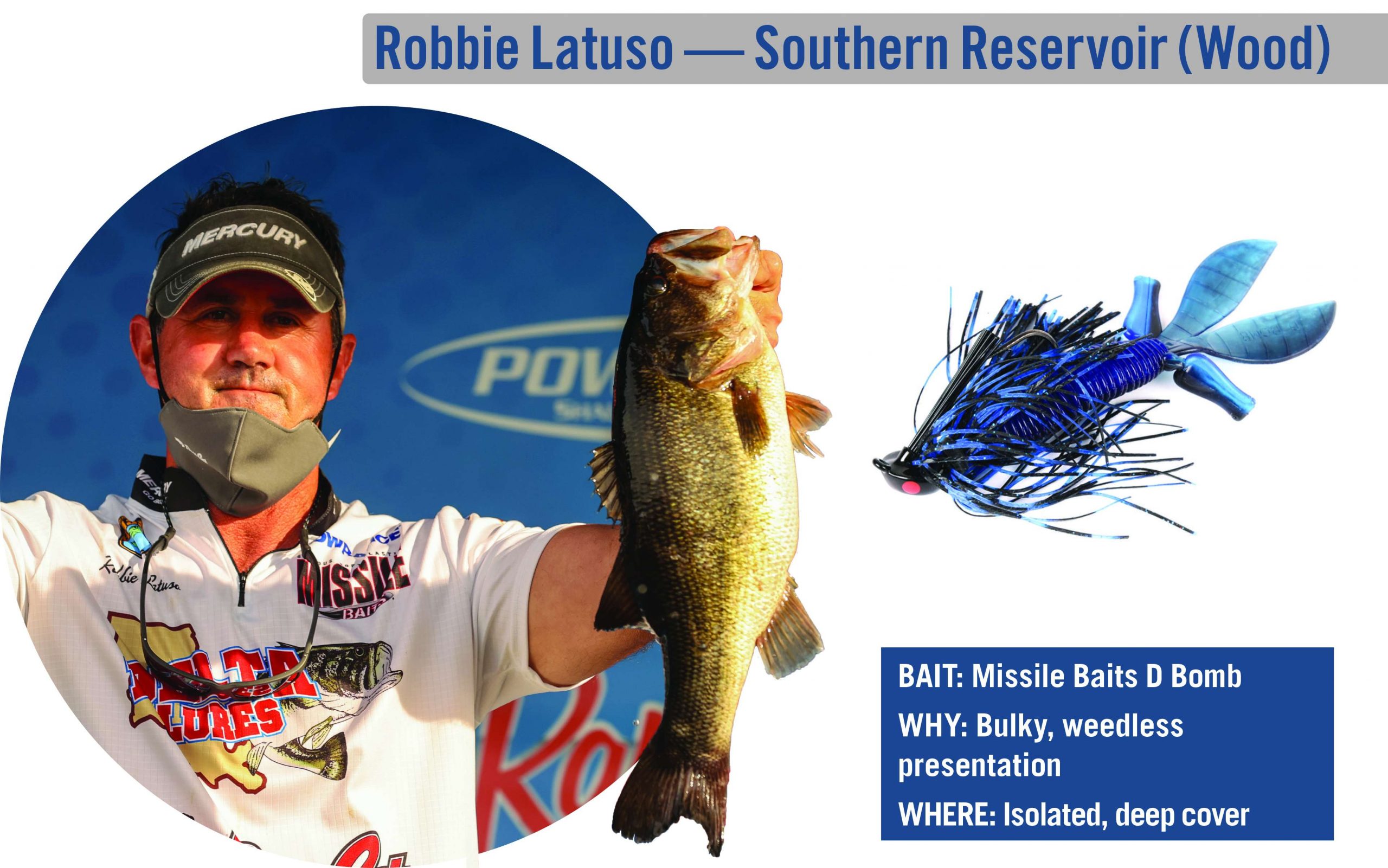
Robbie Latuso
Across the Deep South, April will still have plenty of spawning fish, so the pro from Gonzales, La., will glue his boat to a creek channel and search for a sweet little bend. Where deep water noses in toward the bank is always a high-percentage spot in Latuso’s book, as big fish have the safety of deep water close to their spawning flats.
“The creek channels are their highways, and whenever you have a bend, they tend to slide up there, more than on a straight creek channel,” Latuso said. “And if you have some wood or stumps near that bend, that’s a bonus.”
Knowing this isn’t likely to be a numbers deal, Latuso does expect to encounter his best shots at the true tanks roaming around the adjacent shallows. Depth, he said, varies depending on water clarity, but the simple rule of thumb says the more stain, the shallower they’ll move.
“There won’t be a bunch of them, but those bigger fish will be around that deeper water,” Latuso said. “After the spawn is over, they’ll bunch up a little more, but in April, we’re still targeting isolated fish.”
Latuso finds his most consistent success by dragging a 1/2-ounce black/blue jig with a black/blue or green pumpkin trailer. He’ll use a Strike King Rage Craw or a Missile Baits D Bomb, as well.
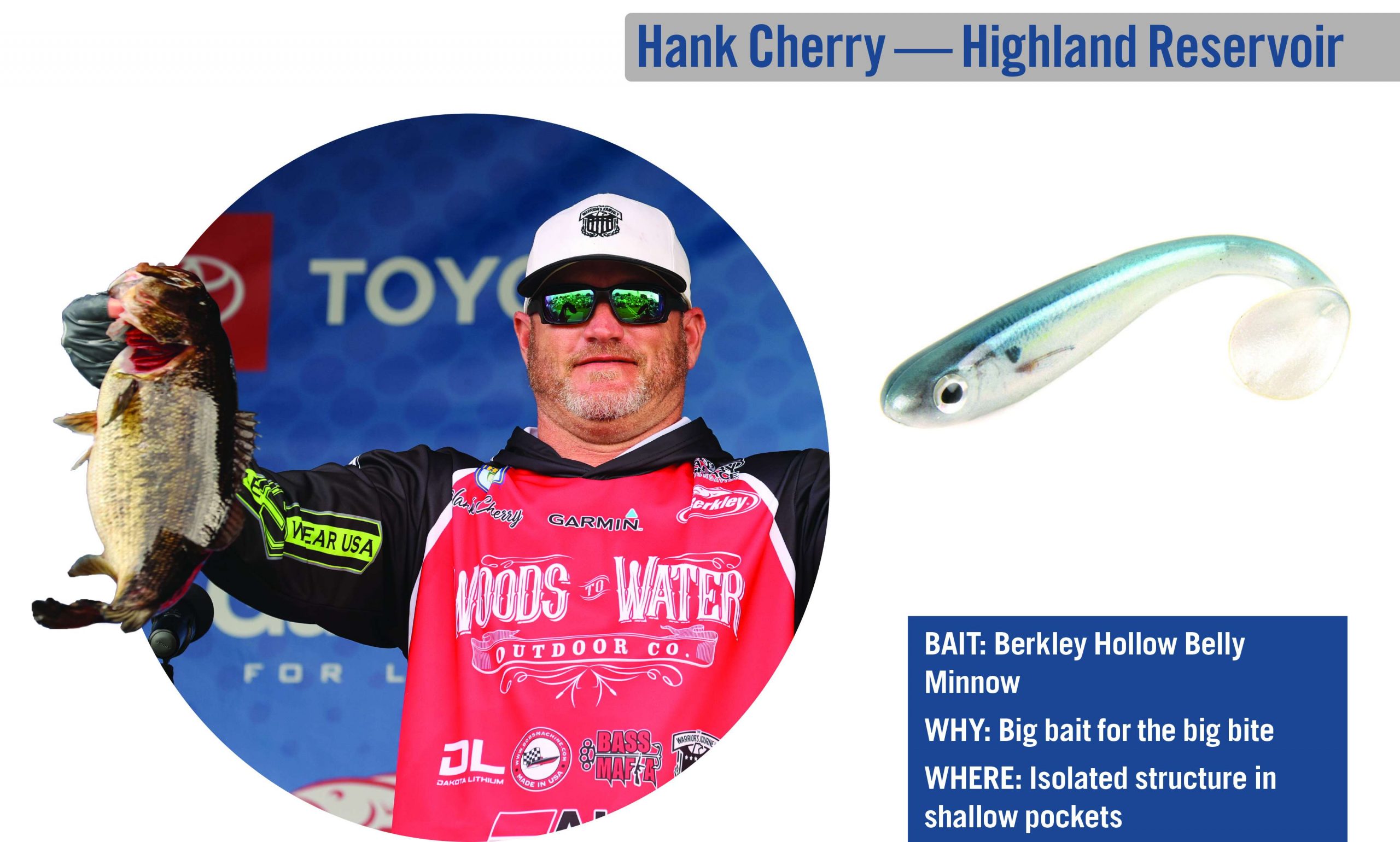
Hank Cherry
Conditions matter as much as location to Cherry, so while he’s scoping out spawning areas, like the side pockets or the backs of creeks with maximum sun exposure, he’s also mindful of current and recent weather patterns. Spawning season is a sensitive time, particularly for the older, wiser fish with the biggest girths.
“I’d pay attention to weather patterns and where the prevailing winds have been coming from,” he said. “I’ll try to go opposite of that to stay on the undisturbed side of the lake.
“If a front were to blow in, especially on a highland reservoir, it’s obvious — you go wherever the wind’s blowing on those banks. But if I’m looking for a true giant, I’m going to look for the most undisturbed place on the lake.”
Cherry said it’s quality over quantity. Unconcerned with catching numbers, he’d rather snoop around the less likely stuff where a legit day-maker may be hiding.
“In places like southern Florida that have huge populations of big fish, they’re historically caught in the same places over and over,” Cherry said. “Typically, on a highland reservoir where you’re dealing with clearer water, the big fish tend to be sneakier and you find them in the most oddball places.
“That may be a pocket with sparse cover, and there may be one log lying in the back. Also, in marinas with floating boatlifts, when people leave them down in the water, I’ve caught giant bass that decided to spawn on top of those things. They’ll use the lift just like hard bottom.”
When Cherry finds one of those big gals, he’s confident he can entice a bite with one of two options: a wacky-rigged 6-inch Berkley PowerBait MaxScent General or a 6-inch Berkley Hollow Belly Minnow. For the latter, he selects his rigging based on habitat — an open-hook jighead in unobstructed water or a weedless swimbait hook setup for a woody area.
Prior to pulling out these baits, Cherry’s typically working a 6- to 8-inch glide bait through promising zones. Preferring a gizzard shad color, he stresses this bait’s utilitarian role.
“You’re using that glide bait as the finder,” Cherry said. “You’re not necessarily going to catch them all on that big bait, but once you find one, you can start working it.
“Remember, this is not a time of year when you need a lot of speed — slower is better. Look for the followers. You might have a 7-pounder that follows the glide bait almost to the boat without eating it. Some fish are more curious than others.”
Originally appeared in Bassmaster Magazine 2021.





